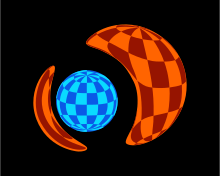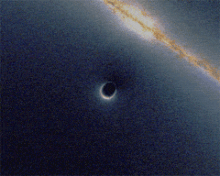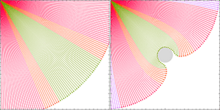Gravitational lensing effect

In astronomy, the gravitational lens effect is the deflection of light by large masses . The name comes from the analogy to optical lenses and the force of gravity .
Basically, the light from a distant source such as a star , a galaxy or another astronomical object is influenced by an object in front of it, the gravitational lens , as seen by the observer .
Light rays that are deflected by a gravitational lens are deflected more strongly towards the mass, the closer they pass to the deflecting mass. A gravitational lens concentrates the light that passes the deflecting mass onto the axis between the object and the observer. Light rays passing the object at different distances intersect the axis at different distances. As a result, a gravitational lens can not generate a real image in the sense of imaging optics . The light distribution generated instead is a caustic .
In the gravitational field of the gravitational lens, the direction of propagation of the light changes so that the position of the source in the sky appears shifted. Your image can also be amplified, distorted or even reproduced. According to the odd number theorem , an uneven number of images always occurs. However, some images can be weakened so much that only an even number can be observed.
Depending on the mass and shape ( mass distribution ) of the objects involved and their position in relation to one another, the effect can vary in strength, from spectacularly distorted multiple images to only slight changes in brightness, so that one speaks of the strong gravitational lens effect , the weak gravitational lens effect and the microlens effect . A special case of the gravitational lensing effect is the cosmic shear .
Isaac Newton already suspected gravitational light deflection in 1704 in the famous Queries No. 1 of his work Opticks . The first quantitative consideration was given around 1800, but it was first correctly described in 1915/16 by Albert Einstein with his general theory of relativity . After the first observations on the sun in 1919 and some theoretical work, however, it was not until 1979 that further gravitational lenses were observed thanks to improved observation techniques. Since then, the gravitational lensing has evolved into a diverse field of observational astronomy and also a tool for other fields such as cosmology .
history
The first targeted experimental review of General Theory of Relativity (GTR), which attracted much public attention and made this theory famous, was conducted in 1919. She checked the ART prediction that light, like all electromagnetic radiation, is deflected in a gravitational field. The solar eclipse of May 29, 1919 was used to measure the apparent displacement of the position of a star near the solar disk , since this is where the effect should be strongest. The prediction of Einstein's theory that starlight that grazes the edge of the sun's disk on its way to Earth should be deflected by 1.75 arc seconds was confirmed in this original measurement with a deviation of 20%.
Classic, d. H. Calculated with the help of Newton's theory of gravity , or with the help of the special theory of relativity , the effect would be only half as large, since only the time coordinate changes and not the space coordinate. The deflection of 0.83 arc seconds following Newton's theory of gravity had already been calculated in March 1801 by Johann Georg von Soldner .
Similar measurements were later made with improved instruments. In the 1960s, the positions of quasars were measured with an accuracy of 1.5%, while similar measurements with the VLBI (Very Long Baseline Interferometry) later increased the accuracy to 0.2%. The positions of 100,000 stars were also measured by the ESA satellite Hipparcos , with which the ART predictions could be checked to an accuracy of 0.1%. The ESA space probe Gaia , which was launched on December 19, 2013, is intended to measure the position of over a billion stars and thus determine the curvature of space even more precisely.
phenomenology
principle
Objects with a very large mass direct electromagnetic waves in a different direction. Accordingly, the image of the background object is displaced, distorted and possibly multiplied.
A special manifestation is the microlensing effect . Here the deflection is so slight that it is not registered as a spatial shift, but rather becomes noticeable as a temporary increase in brightness.
The effect is based in each case on the curvature of space due to objects or energy containing mass, described by Albert Einstein in his general theory of relativity as the effect of gravity on space-time.
This effect can be demonstrated in a total solar eclipse on stars that are very close to the viewing direction to the sun and are otherwise outshone by this: The position of these stars then appears slightly shifted away from the sun. The corresponding observation by Arthur Eddington provided the first experimental confirmation of the general theory of relativity in 1919. Einstein thought it was possible, but hardly likely, that one could see multiple images of the same object under suitable conditions. However, he only thought of stars as the trigger for this effect; In 1937 Fritz Zwicky studied the effect that a galaxy can have as a gravitational lens. In 1963, Yu. G. Klimov, S. Liebes and Sjur Refsdal independently that quasars then represent ideal light sources for this effect.
Strong gravitational lensing effect


To obtain a gravitational lens in the usual, i.e. astronomical, sense, the extremely intense gravitational fields of astronomical objects such as black holes , galaxies or galaxy clusters are normally necessary. With these it is possible that a light source located behind the gravitational lens not only appears shifted, but that the observer sees several images. The first such “strong gravitational lens” was discovered in 1979: the “Twin Quasar” Q0957 + 561 . A well-known example is the Einstein Cross , discovered in 1985 in the constellation Pegasus , a fourfold image of the same object. Under certain circumstances, the object behind the gravitational lens appears as a closed line in the form of an Einstein ring .
The first gravitational lens, which consists not of a single galaxy but of a galaxy cluster ( Abell 370 ), was recognized as such in 1987 by Genevieve Soucail, Yannick Mellier and others in Toulouse and by Vahé Petrosian and Roger Lynds in the USA.
Weak gravitational lensing
In the case of weak distortions - due to a weak or distant gravitational field - the effects of the gravitational lens are not directly visible, since the actual shape of the objects behind the gravitational lens is not known. In this case, the determination of the gravitational field is still possible by statistical methods by examining the shape and orientation of many of the galaxies in the background. It is assumed here that the orientation of the galaxies in the background would be random without a gravitational lens. With a gravitational lens, you get a shear of the background so that galaxies appear more often aligned along a ring around regions with a strong gravitational field. The mass distribution that causes the lens effect can be determined from this.
Since this effect is small, a large number of galaxies must be examined for sufficient statistical significance . A number of possible systematic errors must also be taken into account. These include the intrinsic shape of galaxies, the point spread function of the camera used, imaging errors of the telescope and, under certain circumstances, the unrest in the earth's atmosphere, which can also lead to a distortion of the image.
Microlens effect
- Main article: Micro lens effect
Contrary to what Einstein assumed (see above), the effects that a single star has on the radiation of a background object can also be observed. A number of MACHOs have been detected because a single star has bundled the light of a much weaker object behind it and thus (briefly) amplified it. Also extrasolar planets could be detected with this effect.
The focal point of the lens effect of the sun lies at a distance of about 82.5 billion kilometers or about 550 astronomical units and would produce a magnification by a factor of about 100 million.
In extreme cases, the gravitation of a galaxy can create extreme magnification. This made it possible, for example, to discover the star MACS J1149 Lensed Star 1 , which is the furthest away at 9 billion light years (as of 2018).
Applications
If a gravitational lens (from the point of view of the earthly observer) focuses the light of the background object, objects can be examined which otherwise could not be registered due to their low apparent brightness. This makes it possible to observe galaxies at great distances and thus in very early epochs of the development of the cosmos.
In addition, the distribution of the radiation in the image plane provides the possibility of investigating properties (mass and mass distribution) of the gravitational lens itself. The total mass is obtained directly without having to resort to assumptions regarding the proportion of dark matter .
Statistical evaluations of gravitational lens images can be used to limit parameters such as the cosmological constant or the matter density of the entire universe. The Hubble constant can also be determined more precisely using gravitational lenses, as Sjur Refsdal predicted in 1964. Researchers at the University of Zurich and the USA have thus determined the age of the universe with great accuracy to be 13.5 billion years.
The fact that the object PS1-10afx, discovered by Japanese astronomers in 2010 using the Panoramic Survey Telescope And Rapid Response System ( Pan-STARRS / Hawaii ), was viewed as a hypernova that exploded nine billion years ago, but it was a supernova of Type Ia was similar, but appeared much too bright for that. When, in 2013, a faintly glowing galaxy in the foreground was noticed in this region, which had previously been outshone by the brighter supernova exactly behind it, it became clear that the light emitted during the explosion had been bundled in the direction of the earth by this galaxy's gravitational lens and the supernova was 30 times brighter than it appeared without the magnifying glass effect. On the basis of these observations, astronomers now assume that more such objects will be discovered in the future, because it is considered likely that with increasing distance - somewhere on the path of the supernova radiation to Earth - a gravitational lensing effect can occur.
literature
- Peter Schneider, Jürgen Ehlers , Emilio E. Falco: Gravitational Lenses . Springer, Berlin 1999, ISBN 978-3-540-66506-9 .
- Joachim Wambsganß : Gravitational lenses - universal tools of astrophysics . 1999 ( PostScript file)
- Frédéric Courbin, et al .: Gravitational lensing - an astrophysical tool. Springer, Berlin 2002, ISBN 3-540-44355-X .
- Peter Schneider, Chris Kochanek, Joachim Wambsganss: Gravitational Lensing: Strong, Weak and Micro . Saas Fee Advanced Course 33, Springer, Berlin 2006, ISBN 3-540-30309-X .
- Tommaso Treu, Philip J. Marshall, Douglas Clowe: Resource Letter: Gravitational Lensing . arxiv : 1206.0791 (overview of specialist and general literature on the subject of gravitational lenses)
Web links
- Albert Einstein: Lens effect through the deflection effect of the gravitational field of a star . In: alberteinstein.info . April 12, 1936.
Individual evidence
- ↑ Chris Kitchin: Exoplanets: finding, exploring, and understanding alien worlds , Springer 2012, ISBN 978-1-4614-0643-3 , Appendix IV p. 255 ff.
- ^ Isaac Newton : Opticks : or, a treatise of the reflections, refractions, inflexions and colors of light. Also two treatises of the species and magnitude of curvilinear figures . Octavo, Palo Alto, California 1998, ISBN 1-891788-04-3 (English, annotated by Nicholas Humez. Opticks was originally published in 1704).
- ^ Albert Einstein: Lens-Like Action of a Star by the Deviation of Light in the Gravitational Field Science, Vol. 84, No. 2188, December 4, 1936, pp. 506-507, pdf ; Sidney Dear: Gravitational Lenses . Physical Review, vol. 133, Issue 3B, 1964, pp. 835-844. bibcode : 1964PhRv..133..835L
- ^ VR Eshleman: Gravitational lens of the sun - Its potential for observations and communications over interstellar distances. Science, vol. 205, Sep. 14, 1979, pp. 1133-1135. bibcode : 1979Sci ... 205.1133E
- ^ Frank W. Dyson , Arthur Stanley Eddington , C. Davidson: A Determination of the Deflection of Light by the Sun's Gravitational Field, from Observations Made at the Total Eclipse of May 29, 1919 . In: Philos. Trans. Royal Soc. London . 220A, 1920, pp. 291-333. (English)
- ↑ Johann Georg von Soldner : About the deflection of a ray of light from its straight-line movement, through the attraction of a cosmic body, which it passes close . In: Berlin Astronomical Yearbook . 1804, pp. 161-172.
- ↑ Peter Schneider: Gravitational Lenses: The weak lens effect. In: astro.uni-bonn.de. Archived from the original on March 2, 2016 ; Retrieved August 22, 2013 .
- ↑ Kelly, Patrick L .: Extreme magnification of an individual star at redshift 1.5 by a galaxy-cluster lens . In: Nature Astronomy . 2, No. 4, April 2, 2018, pp. 334–342. arxiv : 1706.10279 . bibcode : 2018NatAs ... 2..334K . doi : 10.1038 / s41550-018-0430-3 .
- ↑ Ann Jenkins, Ray Villard, Patrick Kelly: Hubble Uncovers the Farthest Star Ever Seen . In: NASA . April 2, 2018. Retrieved April 2, 2018.
- ↑ Manfred Lindinger: Strange star explosion brighter than allowed. In: Frankfurter Allgemeine Zeitung . April 25, 2014. Retrieved July 25, 2017 .



